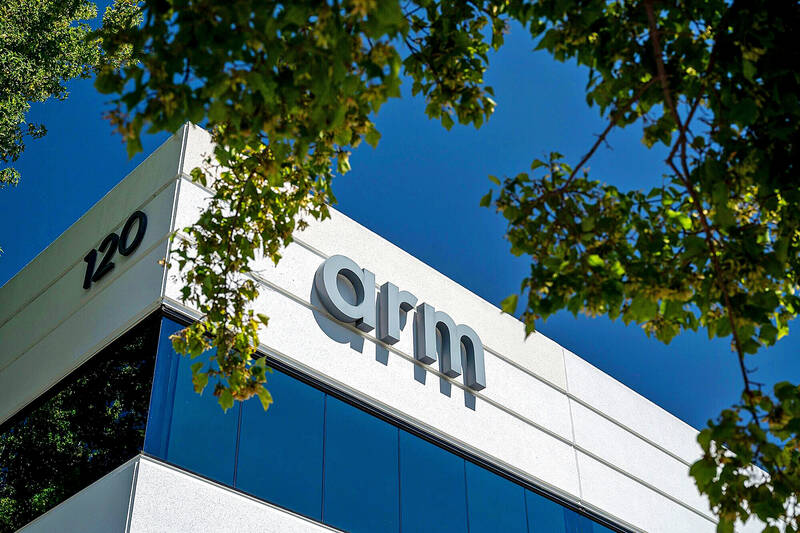Arm Holdings PLC CEO Rene Haas, gearing up for the biggest initial public offering (IPO) of the year, is pitching investors on a pivot.
His message to potential shareholders is that Arm is poised to become a bigger and more profitable business — not just because of the industrywide boom in cloud computing and artificial intelligence, but also due to a major change in how it operates.
“We made a significant shift in our strategy,” Haas said in a video presentation for prospective investors seen by Bloomberg.

Photo: Bloomberg
For most of its history, Arm’s main focus has been designing chips for smartphones and other electronics, and then selling that technology for pennies per chip to companies such as Qualcomm Inc.
However, Arm is now doing complex design work focused on specific products, tailored for what it sees as key areas of growth.
It is a “purpose-built approach” addressing the urgent needs of companies making mobile devices, cloud computing, vehicle electronics and Internet-connected technology, Haas said in the presentation.
Getting that message across is key to the lofty valuation.
Arm had said that it is seeking as much as US$54.5 billion in its IPO this week, although it is proving so popular with investors that the company might raise the price range for the shares.
The listing is oversubscribed by 10 times, and bankers were planning to stop taking orders by yesterday afternoon, a day early, people familiar with the matter had said.
Taiwan Semiconductor Manufacturing Co (TSMC, 台積電), the world’s largest contract chipmaker, is backing Arm’s IPO and plans to be a strategic investor.
The company’s board of directors has approved a maximum investment of US$100 million to subscribe to Arm’s American depositary shares, TSMC said yesterday.
By investing in Arm TSMC aims to gain an advantage for itself, as well as its customers and supply chain partners, the company said in a statement.
“Since chip designing is a highly competitive sector, it is crucial to prevent Arm from being acquired entirely by a rival,” an industry analyst, who asked to remain anonymous, told the Taipei Times yesterday.
MediaTek Inc (聯發科) is one of Arm’s top five customers and TSMC’s major customers almost all use Arm-based architecture.
MediaTek has yet to disclose what it plans to invest in Arm, although the firm’s name is on the IPO prospectus.
Chipmakers such as Qualcomm and Broadcom Inc have licensed Arm’s partial designs and computer code and put them in their own chips. The products adhere to industry standards, making it easy for software makers to ensure that various forms of technology are compatible. That is why Arm’s designs are in nearly every mobile phone made today.
Haas has flipped Arm’s emphasis, saying more is not necessarily better.
He has pushed the company to move beyond licensing the basic building blocks of chips, and instead provide customers with blueprints they can take straight to the factory and put into production.
Now Arm is charging much higher royalty rates per device, because it offers customers more complete designs that are more technologically capable.
While Arm might get paid a low-single-digit dollar figure on a US$30 main chip in a smartphone, the potential inside the kind of processor that is at the heart of a cloud data center is much greater. In that kind of environment, chips can have more than 100 computing cores, or mini processors, and Arm can charge more than US$1 per core.
The revenue opportunity in cloud computing would grow to US$28 billion by 2025, expanding at a rate of 17 percent per year from now, Arm chief financial officer Jason Childs said in the video presentation.
Additional reporting by Lisa Wang

CHIP RACE: Three years of overbroad export controls drove foreign competitors to pursue their own AI chips, and ‘cost US taxpayers billions of dollars,’ Nvidia said China has figured out the US strategy for allowing it to buy Nvidia Corp’s H200s and is rejecting the artificial intelligence (AI) chip in favor of domestically developed semiconductors, White House AI adviser David Sacks said, citing news reports. US President Donald Trump on Monday said that he would allow shipments of Nvidia’s H200 chips to China, part of an administration effort backed by Sacks to challenge Chinese tech champions such as Huawei Technologies Co (華為) by bringing US competition to their home market. On Friday, Sacks signaled that he was uncertain about whether that approach would work. “They’re rejecting our chips,” Sacks

NATIONAL SECURITY: Intel’s testing of ACM tools despite US government control ‘highlights egregious gaps in US technology protection policies,’ a former official said Chipmaker Intel Corp has tested chipmaking tools this year from a toolmaker with deep roots in China and two overseas units that were targeted by US sanctions, according to two sources with direct knowledge of the matter. Intel, which fended off calls for its CEO’s resignation from US President Donald Trump in August over his alleged ties to China, got the tools from ACM Research Inc, a Fremont, California-based producer of chipmaking equipment. Two of ACM’s units, based in Shanghai and South Korea, were among a number of firms barred last year from receiving US technology over claims they have

It is challenging to build infrastructure in much of Europe. Constrained budgets and polarized politics tend to undermine long-term projects, forcing officials to react to emergencies rather than plan for the future. Not in Austria. Today, the country is to officially open its Koralmbahn tunnel, the 5.9 billion euro (US$6.9 billion) centerpiece of a groundbreaking new railway that will eventually run from Poland’s Baltic coast to the Adriatic Sea, transforming travel within Austria and positioning the Alpine nation at the forefront of logistics in Europe. “It is Austria’s biggest socio-economic experiment in over a century,” said Eric Kirschner, an economist at Graz-based Joanneum

BUBBLE? Only a handful of companies are seeing rapid revenue growth and higher valuations, and it is not enough to call the AI trend a transformation, an analyst said Artificial intelligence (AI) is entering a more challenging phase next year as companies move beyond experimentation and begin demanding clear financial returns from a technology that has delivered big gains to only a small group of early adopters, PricewaterhouseCoopers (PwC) Taiwan said yesterday. Most organizations have been able to justify AI investments through cost recovery or modest efficiency gains, but few have achieved meaningful revenue growth or long-term competitive advantage, the consultancy said in its 2026 AI Business Predictions report. This growing performance gap is forcing executives to reconsider how AI is deployed across their organizations, it said. “Many companies